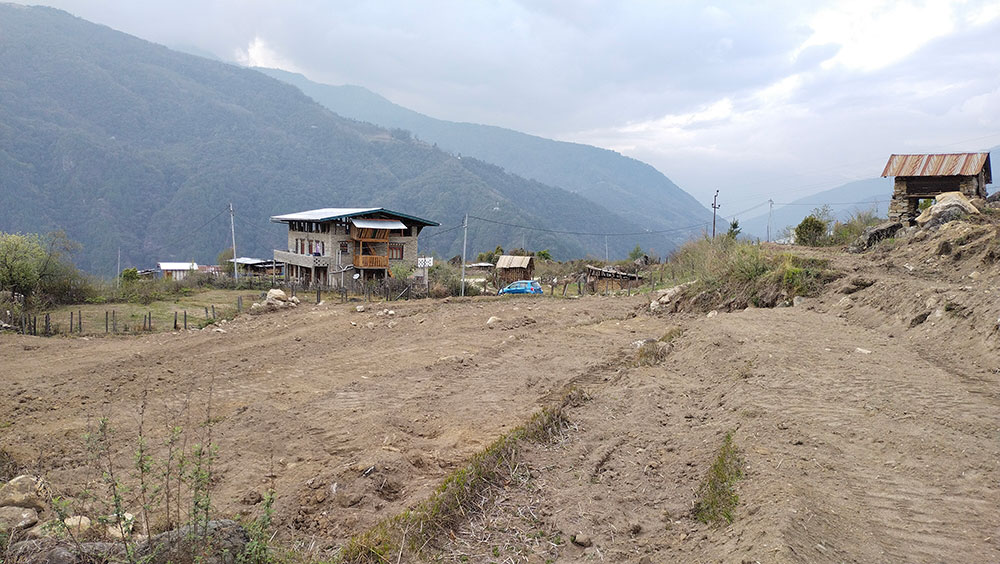Neten Dorji
Trashiyangtse—Tshering Yueden of Bimkhar in Trashiyangtse has revived about 1.8 acres of fallow land after more than a decade of neglect.
The revival was made possible with the support of the government and other agencies.
Increasing human-wildlife conflict,rocky soil and shortage of manpower forced Tshering Yueden to leave the land fallow.
It is not easy for landowners to overcome and initiate land reclamation efforts on their own.
The dzongkhag administration provides them with machinery and resources to make terraces again.
“Without the government’s help, the cost of reviving fallow land will be too expensive for us,” said Tshering Yueden.”
As a result of land management, most of the farmers have replaced oxen with power tillers.
Thujey Namgay, another farmer, said that most of the landowners were eager to venture into farming on fallow land.
“Land management and electric fencing have encouraged landowners like me to engage in agricultural work,” he said. “Most of the farmers are determined to cultivate paddy and start vegetable cultivation on a commercial scale.”
People have plans to gradually take up paddy farming on all uncultivated land if they receive the same support from the government.
With the dzongkhag agriculture sector undertaking numerous land reclamation projects, many abandoned farmlands across eight gewogs in Trashiyangtse dzongkhag are getting a makeover.
A farmer from Jamkhar, Ugyen Lhamo, said that the extension of terraces allowed farmers to use power tillers in paddy fields.
“My 50-decimal land, previously left uncultivated, has been made cultivable,” she said. “I will cultivate paddy and take advantage of market opportunities.”
She said that such initiatives could contribute to ensuring food self-sufficiency in the country.
Farmers say that without government assistance, the costs incurred in land processing activities are too expensive.
“Farmers are determined to transform their fallow land into lush green paddy fields and upscale the vegetables and other agriculture production,” said a farmer, Tashila, from Yangtse.
According to dzongkhag agriculture sector, some 301.46 acres of wetland and 127.1 acres of dry land in the dzongkhag were consolidated and made into terraces.
This initiative has been given priority to upscale agricultural production.
The revival attempt was possible through the land development project initiated by the Commercial Agriculture and Resilient Livelihoods Enhancement Programme (CARLEP) under the Ministry of Agriculture and Forests and other agencies like Royal Society for Protection of Nature and National organic flagship programme.
Dzongkhag agriculture officer, Chhimi Dakpa, said the reclamation project received positive feedback from the people.
“Since most of the land is located in sloppy areas, dry land terracing helps to protect the soil from erosion and also prevents manure from washing away during the rainy season,” he said. “Additionally, it is much more convenient for farmers to work on terraces than in sloped areas.”
According to the dzongkhag agriculture sector, they are reviving fallow land through schemes like the construction of irrigation channels, introduction of women-friendly farm machines, installation of chain link fences in each and every chiwog, proper farm roads for the transportation of agricultural produce, encouragement of youth to take up agri-enterprise, and carrying out land development.
However, going by the dzongkhag statistics, Trashiyangtse still has 943.642 wetland and 4,742 acres of dry land fallow land to be revived in all eight gewogs.
Local leaders say that reclaiming land near Drangmechu river banks offers the potential for wetlands, which would be a significant advantage to paddy production.
“If the policies support the revival of fallow lands, farmers have the ability to continue to work for success in farming,” says Toedtsho gup, Dechen Wangdi, who believes that many farmers have left their lands fallow due to the absence of roads, human-wildlife conflicts, and irrigation canal.
He said the revival of fallow land would encourage farmers to engage in vegetable farming, helping them move towards self-reliance.
“The Tshotsang area has fertile land and favourable weather where paddy can be produced twice a year,” he said. “If the people receive proper land management, this will encourage them to pursue commercial farming.”
He said that people only need access to roads, land management, chain-link fencing, and markets to do farming.
Jamkhar gup, Cheku, said that while the government supported with a huge amount of budget for land management, people should be accountable.
“We have drawn agreements between people and the gewog administration to ensure that reclaimed land through land management is cultivated.”
Between 2016 and 2023, the government spent approximately Nu. 13.305 million on land development in Trashiyangtse.


